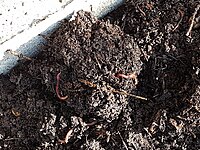
Photo from wikipedia
As a natural organic compound secreted by arbuscular mycorrhizal fungi (AMF), glomalin-related soil protein (GRSP) is an important part in soil, affecting the bioavailability of polycyclic aromatic hydrocarbons (PAHs) in… Click to show full abstract
As a natural organic compound secreted by arbuscular mycorrhizal fungi (AMF), glomalin-related soil protein (GRSP) is an important part in soil, affecting the bioavailability of polycyclic aromatic hydrocarbons (PAHs) in it. Previous research have demonstrated that GRSP could enhance the availability of PAHs in the soil and favor their accumulation in plant roots. However, a scarcity of research exists on the different molecular weights of GRSP interacting with PAHs due to their complexation and heterogeneity. In this research, the extracted GRSP in soil was divided into three molecular weight (Mw) fractions of GRSP (<3,000, 3,000–10,000, and >10,000 Da), whose characteristics and binding capacity of PAHs were conducted by using UV–visible absorption, quenching fluorometry and, Fourier transform infrared spectroscopy. The results showed that the GRSP was composed of abundant compounds, it has a wide distribution of molecular weight, and the >10,000 Da Mw fraction was dominant. For three Mw fractions of GRSP, they have some difference in spectral features, for example, the >10,000 Da fraction showed higher dissolved organic carbon (DOC) contents, more phenolic hydroxyl groups, and stronger UV adsorption capacity than the low and middle Mw fractions. In addition, the interaction between GRSP and phenanthrene is related to the characteristics of the Mw fractions, especially the phenolic hydroxyl group, which has a significantly positive correlation with a binding coefficient of KA (k = 0.992, p < 0.01). Simultaneously, hydrophobic, NH-π, and H-bound also played roles in the complexation of phenanthrene with GRSP. These findings suggested that different GRSPMw fractions could influence the fate, availability, and toxicity of PAHs in soil by their interaction.
Journal Title: Frontiers in Microbiology
Year Published: 2021
Link to full text (if available)
Share on Social Media: Sign Up to like & get
recommendations!